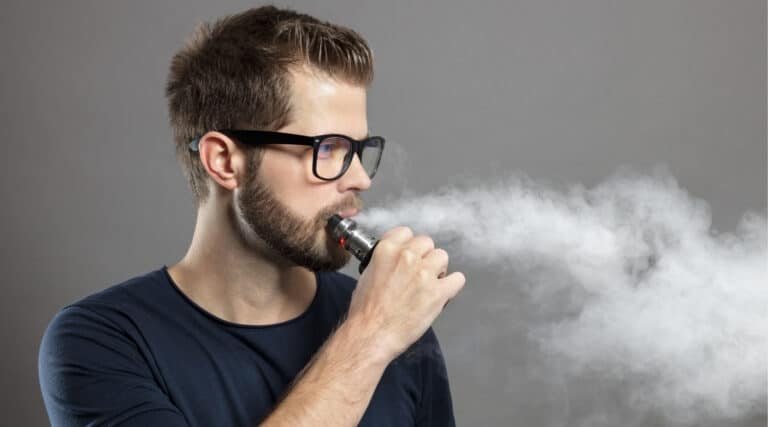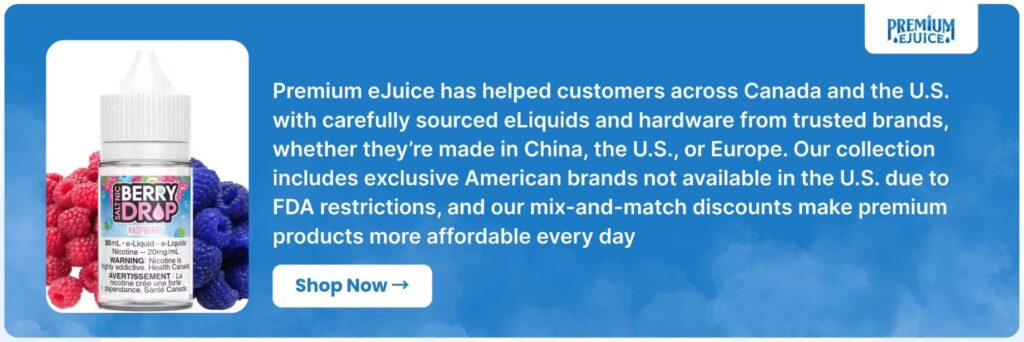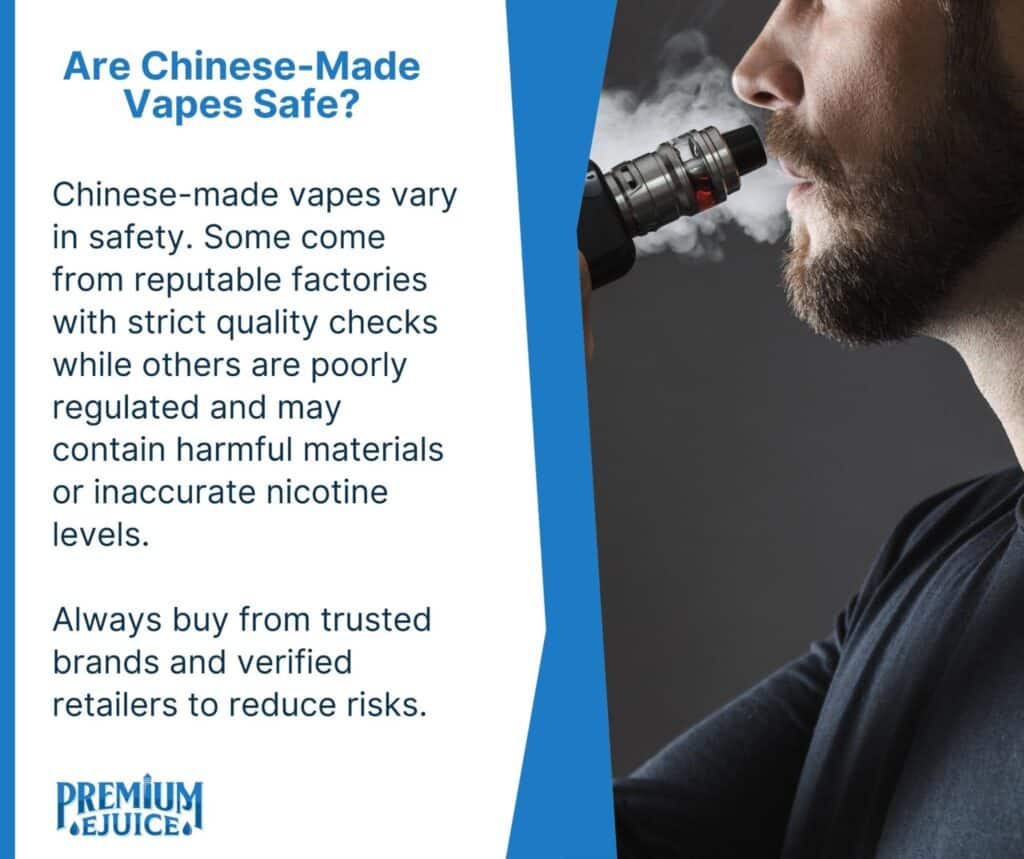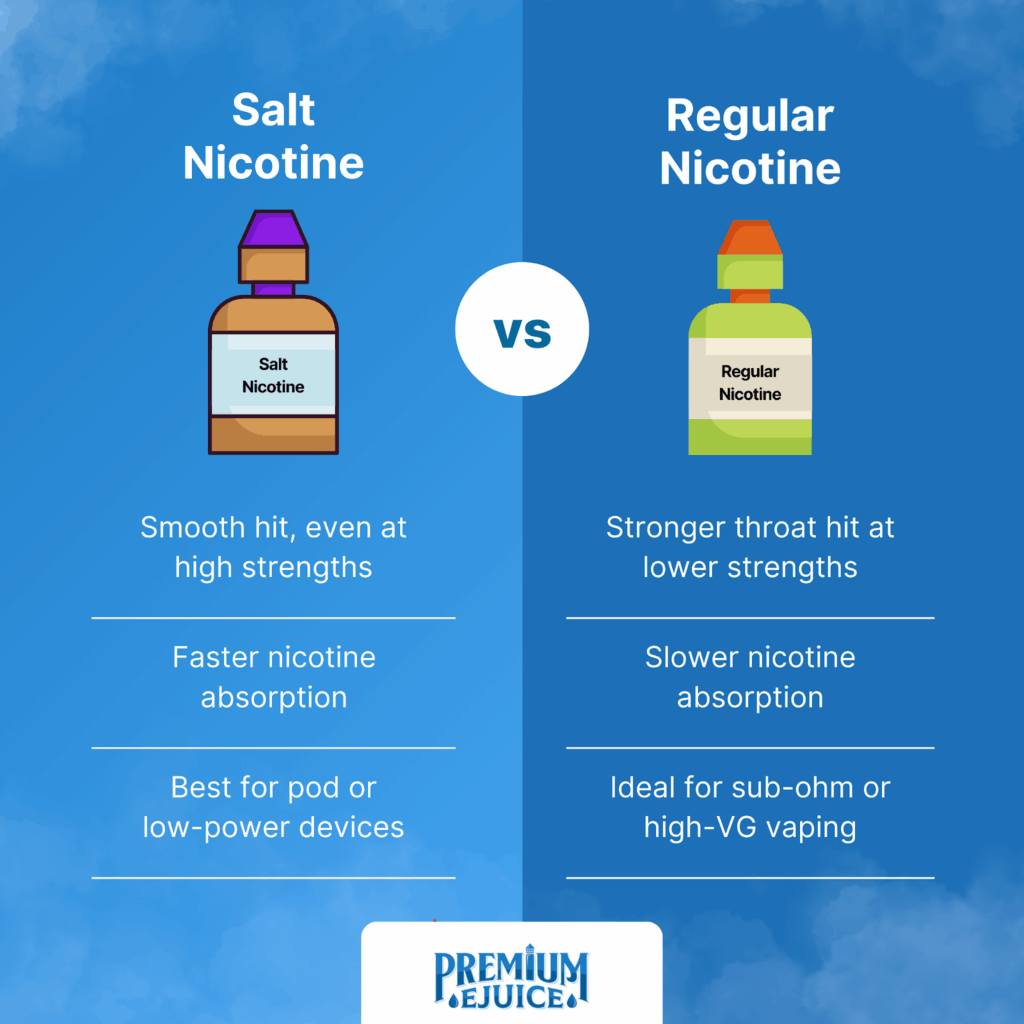Are All Vapes Made In China? Trusted Brands & Safer Options

Most vapes are made in China, including popular disposable and refillable devices. However, some high-end models and e-liquids are manufactured in the U.S., Europe, and elsewhere. Manufacturing origin varies by brand, product type, and regulatory environment.
A lot of vapers have wondered whether their vape devices or e-liquids were manufactured in China. For many vapers, this question is rooted in concern, such as, Is it safe? Is it authentic? Could I find a better-made option from a North American brand? And perhaps most importantly, does Made in China automatically mean lower quality?
Here’s what you need to know:
- Over 90% of vape products, especially hardware, are manufactured in Shenzhen, China, a region known for both rapid innovation and counterfeit risks.
- While many major U.S. and EU brands rely on Chinese factories, a growing number of high-end devices and e-liquids come from the U.S., Germany, and Italy.
- Regulations, safety standards, and even excise taxes play a huge role in where and how vapes are made, and how they reach your hands.
If you’re looking for a full breakdown of what’s made in China, what’s not, and how to spot the difference, you’re in the right place. Let’s dive in.
China’s Dominance in Vape Manufacturing, And Why
If the vape in your hand was made anywhere, odds are it came from Shenzhen. Over 90% of the world’s vape hardware, pods, coils, disposables, and mods are manufactured in this bustling tech hub in southern China. Shenzhen’s 5-square-mile vape zone is home to over 600 factories dedicated to the production and assembly of vaping products.
But China’s dominance in this space is both historical and deeply strategic.
The Origin Story: China Invented the E-Cigarette
The modern e-cigarette was born in China in 2003, when pharmacist Hon Lik developed the first commercially viable vape device. What started as a smoking cessation tool quickly became a global category, and China, with its massive electronics infrastructure, capitalized on it.
Today, Chinese factories produce hardware at an unmatched scale, and they’re also leading innovation. Features like puff counters, Bluetooth tracking, and even LCD screens now debut in Chinese-designed disposables long before they reach the Western market.
Why the World Still Depends on China
There are three main reasons vape manufacturing remains concentrated in China:
- Low Labor Costs: China’s workforce enables brands to produce at scale while keeping prices low, especially for disposables and starter kits.
- Vertically Integrated Supply Chains: Shenzhen hosts not just assemblers, but component suppliers, batteries, chipsets, coil wire, and wicking cotton, allowing rapid development cycles.
- Manufacturing Speed: Factories can go from prototype to full production in weeks, not months.
Even American and European brands rely on Chinese factories. Many outsource production entirely, keeping only design, branding, and packaging in-house. It’s not just about cost, it’s about efficiency.
Are Disposable Vapes Made in China?
Absolutely. In fact, virtually every disposable vape on the market is manufactured in China. Popular names like Geek Bar, Elf Bar, Fifty Bar, and Flavour Beast are all produced in large Chinese facilities using automated processes that ensure consistency and scalability.
Why Are Chinese Disposables So Popular?
There’s no denying their appeal:
- Affordable: Mass production keeps costs low
- Convenient: No charging, refilling, or mess
- Flavorful: Bold, sweet flavor profiles dominate the market
- Available Everywhere: Found in gas stations, convenience stores, and online shops across North America
Chinese disposables are often better tasting and more reliable than early North American counterparts, something many customers have experienced firsthand.
The Risks: Counterfeits and Illicit Imports
With popularity comes imitation. Many counterfeit disposables are now smuggled into Canada and the U.S., especially as regulators crack down on flavored high-nicotine products. These fakes may:
- Contain unknown chemical compositions
- Use unregulated batteries
- Lack tamper-proof packaging or batch codes
Because most disposable vapes look alike, it’s almost impossible for the average buyer to tell real from fake. This has led to growing concerns about safety and long-term health effects, especially among younger or newer vapers.
The Smart Vape Surge
Shenzhen has also ushered in a new category of disposables known as smart vapes, featuring tech features like LED screens, USB-C charging, and puff counters. While impressive, these features raise environmental concerns due to increased electronic waste and further blur the line between safe, regulated products and high-tech gimmicks.
Are Chinese-Made Vapes Safe?
Some are, and some absolutely aren’t.
China’s vape manufacturing sector includes everything from state-of-the-art facilities producing for globally trusted brands to small-scale factories pushing out copycat devices with minimal oversight. This vast gap in quality control is why so many vapers remain skeptical.
Trusted Brands vs. Unknown Origins
Many reputable vape companies, like SMOK, Vaporesso, and Geek Bar, have invested heavily in quality assurance and third-party testing. Their Chinese-made devices often go through rigorous processes, including:
- Leak testing
- Battery safety verification
- Ingredient transparency in eLiquids
- Compliance with CE, UL, and RoHS certifications
These brands have built a track record of consistency and reliability, regardless of where they’re made.
But at the other end of the spectrum are unregulated manufacturers cutting corners to keep prices low. These devices may:
- Contain excessive or poorly measured nicotine
- Use cheap plastics or heavy metals
- Skip safety mechanisms that prevent battery overheating or short circuits
For customers, it’s often impossible to know which category their vape falls into, unless they’re buying from a trusted source.
Can You Trust the Labels?
It’s not just the device that matters, but also the packaging. Many knockoffs carry fake safety certifications. Just because a box has a CE or RoHS logo doesn’t mean it passed inspection. In fact, some counterfeiters go as far as copying holographic seals and batch verification stickers used by legitimate brands.
How to Tell If Your Vape is Counterfeit or Unsafe
You don’t need a lab to spot a fake vape. Here are some red flags and best practices every vaper should know.
Packaging Red Flags
- Misspelled words or blurry print on the box
- No batch number or manufacturing date
- Suspicious QR codes that lead to broken or generic websites
- Lack of tamper-proof seals or authentication stickers
Trustworthy brands often invest in packaging that makes counterfeiting more difficult. If a product looks cheap or unprofessional, it probably is.
Check Before You Hit
Before you take a puff, take a minute:
- Scan authentication codes via the brand’s website (if offered)
- Compare packaging with images on the brand’s official site
- Avoid resellers that don’t specialize in vape products, especially convenience stores and marketplaces like Wish or AliExpress
Why Fake Vapes Are Worse Than Just a Bad Buy
Counterfeit vapes are a rip-off, and can be dangerous:
- Overfilled tanks can leak or spit hot liquid
- Poor-quality batteries may explode or cause burns
- Unknown e-liquid compositions could contain banned additives or contaminants
That’s why trusted retailers, like Premium eJuice, take these risks seriously. Every product we carry is sourced directly from the manufacturer or licensed distributor. No grey market. No sketchy imports.
Are There Any Vapes Not Made in China?
Yes, vapes do exist outside of China, but they’re the exception, not the rule.
While the majority of vape hardware and disposables are made in Shenzhen, a niche segment of the market produces high-end gear in countries like Germany, the United States, Greece, Italy, and the Philippines. These products are usually mech mods, rebuildable atomizers, or custom devices targeted at hobbyists and advanced users, not your average beginner-friendly vape pen.
But even when devices are assembled elsewhere, many of their internal components, batteries, wires, chips, and cotton still come from Chinese suppliers. Full control over every part of the supply chain is rare, making true non-Chinese devices nearly impossible to source for mass-market use.
So while the label may read Made in Italy or Assembled in the USA, don’t assume every piece was sourced domestically.
Why Non-Chinese Vapes Are Rare
Cost: Premium Gear Comes at a Premium Price
Devices manufactured outside of China are often handcrafted or produced in small batches. This leads to retail prices of $130 to $300+ CAD, well beyond what most everyday vapers are willing to spend.
These products are designed for enthusiasts who value:
- Exotic materials like stabilized wood or titanium
- Full mechanical control over wattage and resistance
- Unique, limited-run designs
If you’re just looking for a reliable daily vape, these options likely aren’t practical.
Limited Distribution and Supply Chains
Smaller manufacturers outside China don’t have the infrastructure to mass-produce or distribute globally. Their products are harder to find, take longer to ship, and often lack the user-friendly packaging or documentation seen in Chinese-made alternatives.
In many cases, they’re only available through niche vape shops or private resellers, especially in the UK and EU, where regulation complicates cross-border commerce.
Regulatory Pressures Kill Domestic Brands
In the U.S., the FDA’s PMTA process requires companies to spend up to $1.5 million per SKU to get their vape products approved. That’s not just per brand, it’s per flavor, strength, and bottle size combination.
Most American startups simply couldn’t afford to comply. As a result, they shut down, downsized, or outsourced production to China, where they could still manufacture and sell internationally.
Premium eJuice has worked around this by sourcing FDA-restricted U.S. brands and offering them to Canadian and U.S. customers online. Our unique import relationships allow us to carry products you can’t find elsewhere, all while ensuring authenticity and regulatory compliance.
Do E-Liquids Come from China Too?
Yes, some e-liquids are manufactured in China, but the premium segment of the market is dominated by North American producers, especially in Canada and the U.S. Brands based in these regions tend to follow stricter manufacturing protocols and more transparent labelling practices.
What’s most important isn’t where the juice is made, but what’s in it. The formulation, flavoring agents, nicotine quality, and adherence to excise tax laws all play a major role in product quality.
At Premium eJuice, every liquid we carry comes from vetted suppliers who adhere to Canadian excise labelling laws and meet rigorous quality standards. We look beyond the branding to ensure customers get clean, consistent, and compliant products with every bottle.
Ingredient Quality Isn’t Always Obvious
Even experienced vapers often struggle to detect differences in ingredient purity, especially in sweet or complex flavors. While some Chinese-made e-liquids meet international standards, others may use inferior flavoring bases, synthetic nicotine, or inconsistent formulations.
That’s why the most informed customers look for:
- Excise stamps on every bottle
- Ingredient transparency on packaging
- Nicotine consistency across batches
In other words, trustworthy labelling matters more than the country of origin, and that’s where reliable retailers make all the difference.
Freebase vs Salt Nic: Does Origin Matter?
While the manufacturing origin may not directly influence your nicotine experience, the type of nicotine absolutely does.
- Salt Nicotine: Delivers a smoother throat hit, making it ideal for newer vapers or those using small pod systems. In Canada, the legal limit caps salt nic at 20mg, whereas in the U.S., pre-regulation levels were often 35–50mg, leading to very different user experiences.
- Freebase Nicotine: Offers a stronger throat hit and longer-lasting satisfaction. It’s more common in traditional sub-ohm setups and preferred by users looking to taper their nicotine use over time.
Excise taxes in Canada have also impacted how users choose their bottles. With tax calculated per mL, many vapers are switching to larger bottle sizes of lower strengths to minimize cost while maintaining volume. That’s led to a shift in consumer habits, not just based on preference, but economics.
Premium eJuice supports both freebase and salt nic users with transparent labelling, tax-stamped compliance, and a wide selection of strengths designed to meet evolving customer needs.
Helpful Resource -> Salt Nic vs Freebase: Which One Should You Use?
How Regulation Shapes Where Vapes Are Made
If you’re wondering why more vape products aren’t made in North America, regulatory pressure is the answer.
The U.S. PMTA Wipeout
In the United States, every vape product, down to the individual strength and flavor variation, requires a Premarket Tobacco Product Application (PMTA). The cost? Roughly $1.5 million per SKU.
For small- to mid-sized American companies, these costs were impossible to absorb. As a result, thousands of legitimate domestic manufacturers exited the market or were forced to outsource production to China, where PMTA rules don’t apply.
This regulation reduced product diversity and created a vacuum quickly filled by unregulated imports, many of them illicit or mislabelled.
Canada’s Excise Stamp Bottleneck
In Canada, new excise stamp laws have similarly restricted which products can be legally sold. If a bottle doesn’t have the proper regional excise stamp, it can’t be stocked, no matter how high the quality.
This has created regional shortages and pushed more consumers toward multi-jurisdictional retailers like Premium eJuice, who are equipped to navigate this evolving regulatory maze and maintain stock from legally compliant brands across Canada and the U.S.
Illicit Market Dangers & Misconceptions
The combination of high excise taxes and flavor bans has created the perfect environment for the illicit market to thrive. Unregulated imports, often from low-quality Chinese manufacturers, are flooding convenience stores, gas stations, and online resellers.
These products:
- May bypass safety testing
- Often avoid excise taxes
- Lack authenticity tracking or batch control
And yet, many consumers buy them unknowingly, simply because they’re widely available and inexpensive.
But the important myth to bust is that not all Chinese-made vapes are low-quality, and not all North American-made products are safe. It’s not about origin alone, but also about oversight, intent, and retailer transparency.
That’s why Premium eJuice focuses on products that meet excise and labelling requirements while sourcing from brands with a verifiable track record. Because whether a product is made in Shenzhen or Salt Lake City, what matters is what’s in the bottle and how it gets to your hands.
How to Buy Safe, High-Quality Vapes, Wherever They’re Made
At the end of the day, it’s not just about where your vape is made, it’s about who you trust to sell it. Counterfeit products, mislabelled nicotine strengths, and unregulated imports don’t usually come from certified retailers. They come from gas stations, corner stores, and social media sellers who prioritize speed and margin over safety and quality.
If you care about what you’re inhaling, here’s what to look for:
- Buy from reputable online retailers with clearly documented sourcing practices.
- Look for batch numbers, sealed packaging, and excise stamps on bottles and boxes.
- Stick to brands with a proven reputation, not fly-by-night products with flashy names and zero history.
Premium eJuice specializes in helping Canadian and American customers find legally compliant, lab-tested, and excise-approved vape products. We carry both domestic and imported brands, but only those that meet high standards for transparency and safety.
Whether it’s a salt nic pod made in Shenzhen or a freebase bottle blended in Ontario, every item in our shop is handpicked for its authenticity, traceability, and consistency.
Brands & Retailers Offering Verified Alternatives
If you’re looking for vape products with known origins and quality controls, there are a growing number of options:
- North American brands like Canada’s Twelve Monkeys, or U.S. e-liquid producers who still follow GMP manufacturing practices
- Hardware brands with transparent production processes, such as DotMod (U.S.) and SvoëMesto (Germany)
- Canadian retailers like Premium eJuice, who legally import U.S. brands banned domestically due to FDA regulations, allowing Americans to buy products they can’t even access in their own country
Does Made in China Really Matter?
The label “Made in China” is no longer as black-and-white as it once seemed.
On one hand, Chinese factories power the global vape industry with innovation, scalability, and affordability. On the other, lack of consistent regulation means counterfeits, safety risks, and environmental concerns are very real.
But what matters most isn’t the country, it’s the credibility.
If you want consistent quality, where you buy from matters more than where it was made
Trusted retailers will filter out the noise, verify the authenticity, and offer you a product that’s safe, effective, and legal.
Premium eJuice is not here to tell you what country to trust. We’re here to help you make confident, informed decisions, whether you’re shopping for hardware, salt nic, or a new favorite flavor.

Stuart Rosenfarb CEO & Founder of Premium eJuice
Premium eJuice (previously Premium eJuice Samples) was established in 2013 by Founder & CEO Stuart Rosenfarb with the mission of helping as many smokers as possible kick their smoking habit forever, by providing a selection of the highest quality and best-tasting eJuices on the market to ensure a successful and lasting transition from smoking to vaping.



